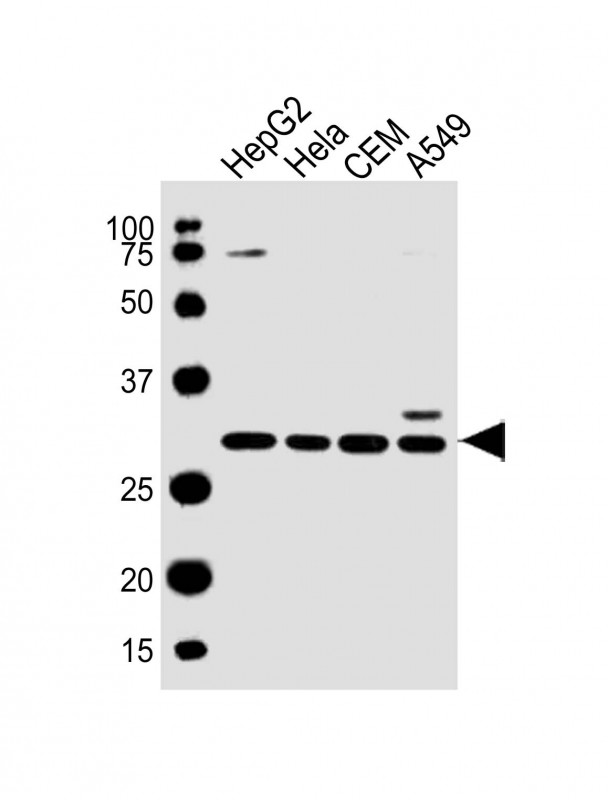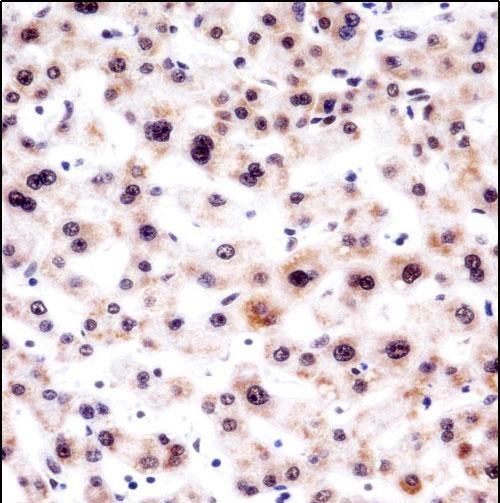SNRPA Antibody (Center)
Affinity Purified Rabbit Polyclonal Antibody (Pab)
- SPECIFICATION
- CITATIONS: 1
- PROTOCOLS
- BACKGROUND

Application
| WB, IHC-P |
|---|---|
| Primary Accession | P09012 |
| Reactivity | Human |
| Host | Rabbit |
| Clonality | Polyclonal |
| Calculated MW | H=31;M=32 KDa |
| Isotype | Rabbit IgG |
| Antigen Source | HUMAN |
| Gene ID | 6626 |
|---|---|
| Antigen Region | 83-111 aa |
| Other Names | U1 small nuclear ribonucleoprotein A, U1 snRNP A, U1-A, U1A, SNRPA |
| Dilution | WB~~1:1000 IHC-P~~1:10~50 |
| Target/Specificity | This SNRPA antibody is generated from rabbits immunized with a KLH conjugated synthetic peptide between 83-111 amino acids from the Central region of human SNRPA. |
| Storage | Maintain refrigerated at 2-8°C for up to 2 weeks. For long term storage store at -20°C in small aliquots to prevent freeze-thaw cycles. |
| Precautions | SNRPA Antibody (Center) is for research use only and not for use in diagnostic or therapeutic procedures. |
| Name | SNRPA |
|---|---|
| Function | Component of the spliceosomal U1 snRNP, which is essential for recognition of the pre-mRNA 5' splice-site and the subsequent assembly of the spliceosome. U1 snRNP is the first snRNP to interact with pre-mRNA. This interaction is required for the subsequent binding of U2 snRNP and the U4/U6/U5 tri-snRNP. SNRPA binds stem loop II of U1 snRNA. In a snRNP-free form (SF-A) may be involved in coupled pre-mRNA splicing and polyadenylation process. May bind preferentially to the 5'-UGCAC-3' motif on RNAs. |
| Cellular Location | Nucleus. |

Provided below are standard protocols that you may find useful for product applications.
Background
The protein encoded by this gene associates with stem loop II of the U1 small nuclear ribonucleoprotein, which binds the 5' splice site of precursor mRNAs and is required for splicing. The encoded protein autoregulates itself by polyadenylation inhibition of its own pre-mRNA via dimerization and has been implicated in the coupling of splicing and polyadenylation.
References
Guan, F., et al. RNA 13(12):2129-2140(2007)
Hall-Pogar, T., et al. RNA 13(7):1103-1115(2007)
Shajani, Z., et al. J. Mol. Biol. 349(4):699-715(2005)
Andersen, J.S., et al. Nature 433(7021):77-83(2005)
Jessen, T.H., et al. EMBO J. 10(11):3447-3456(1991)
If you have used an Abcepta product and would like to share how it has performed, please click on the "Submit Review" button and provide the requested information. Our staff will examine and post your review and contact you if needed.
If you have any additional inquiries please email technical services at tech@abcepta.com.














 Foundational characteristics of cancer include proliferation, angiogenesis, migration, evasion of apoptosis, and cellular immortality. Find key markers for these cellular processes and antibodies to detect them.
Foundational characteristics of cancer include proliferation, angiogenesis, migration, evasion of apoptosis, and cellular immortality. Find key markers for these cellular processes and antibodies to detect them. The SUMOplot™ Analysis Program predicts and scores sumoylation sites in your protein. SUMOylation is a post-translational modification involved in various cellular processes, such as nuclear-cytosolic transport, transcriptional regulation, apoptosis, protein stability, response to stress, and progression through the cell cycle.
The SUMOplot™ Analysis Program predicts and scores sumoylation sites in your protein. SUMOylation is a post-translational modification involved in various cellular processes, such as nuclear-cytosolic transport, transcriptional regulation, apoptosis, protein stability, response to stress, and progression through the cell cycle. The Autophagy Receptor Motif Plotter predicts and scores autophagy receptor binding sites in your protein. Identifying proteins connected to this pathway is critical to understanding the role of autophagy in physiological as well as pathological processes such as development, differentiation, neurodegenerative diseases, stress, infection, and cancer.
The Autophagy Receptor Motif Plotter predicts and scores autophagy receptor binding sites in your protein. Identifying proteins connected to this pathway is critical to understanding the role of autophagy in physiological as well as pathological processes such as development, differentiation, neurodegenerative diseases, stress, infection, and cancer.


